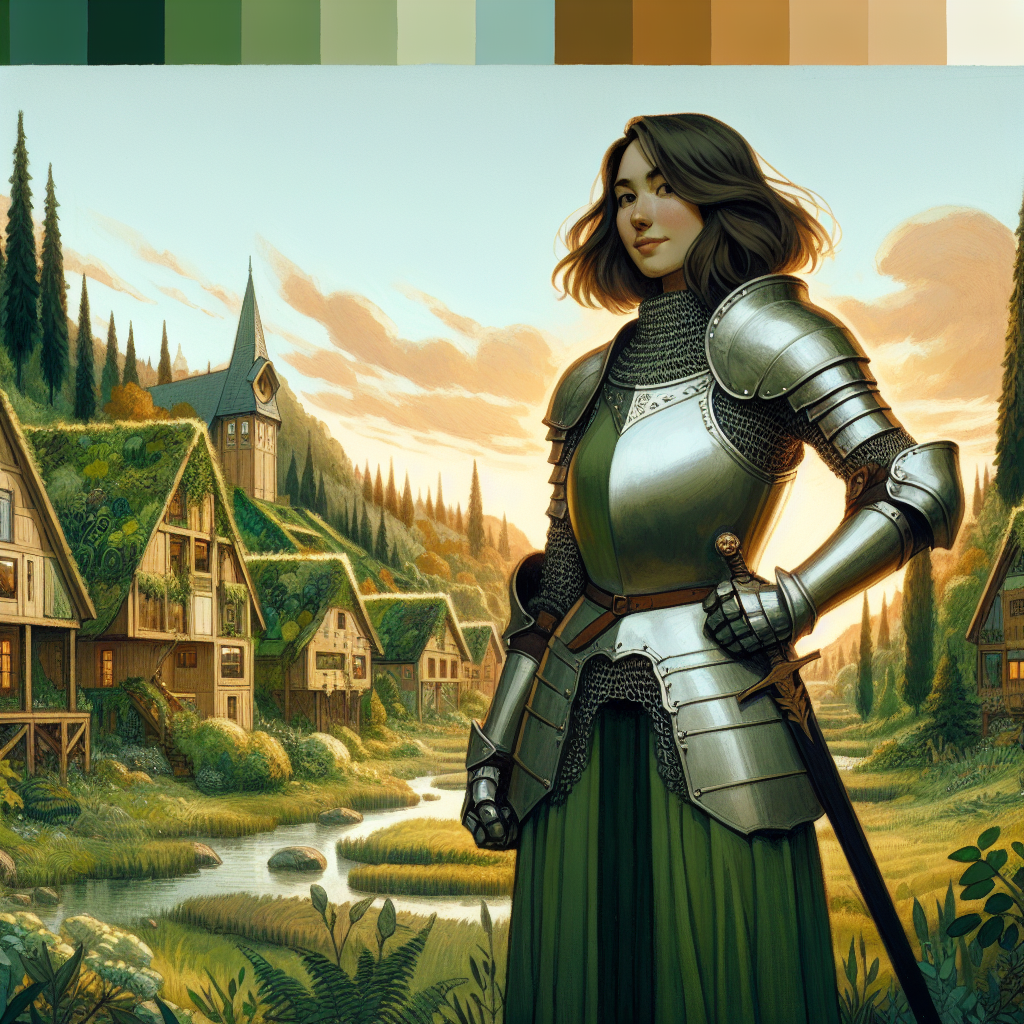Introduction
In the vibrant landscape of Japanese folklore and modern media, tales of mysterious knights and brave warriors abound. One such story that has captured the imagination of many is Kamikatsu. The burning question on everyone’s mind is, “Kamikatsu is the knight actually a girl?” In this blog post, we will explore this intriguing question from various perspectives, shedding light on the cultural, ecological, and gender aspects that make this story so compelling to eco-conscious consumers, sustainable living enthusiasts, and gender equality advocates. By the end of this post, you’ll have a comprehensive understanding of why this question is more than just a simple inquiry—it’s a reflection of broader societal values and ideals.
Who Is Kamikatsu?
Kamikatsu is a name that resonates deeply within Japanese folklore. Often depicted as a valiant knight, Kamikatsu’s tale has been passed down through generations. But what if Kamikatsu is the knight actually a girl? This question challenges traditional narratives and opens the door to a more nuanced understanding of gender roles in folklore. For eco-conscious consumers and sustainable living enthusiasts, Kamikatsu’s story also serves as a metaphor for resilience and adaptation, much like the natural world they strive to protect.
The character of Kamikatsu embodies bravery, skill, and an unwavering commitment to justice. Traditionally, knights are depicted as male warriors, but the question of Kamikatsu is the knight actually a girl invites us to reconsider these stereotypes. By doing so, we not only enrich the story but also make it more inclusive, aligning it with modern values of gender equality and diversity.
In many ways, the question of Kamikatsu is the knight actually a girl is a reflection of broader societal shifts. As we move towards a more inclusive and equitable world, stories like Kamikatsu’s can serve as powerful tools for change. They challenge us to rethink our assumptions and inspire us to build a future where everyone, regardless of gender, can be a hero.
The Cultural Significance
The question of Kamikatsu is the knight actually a girl has profound cultural implications. In traditional Japanese society, gender roles were strictly defined, with men often taking on the role of warriors and protectors. However, folklore has always had the power to transcend these boundaries, offering alternative narratives that challenge the status quo. By asking if Kamikatsu is the knight actually a girl, we open the door to exploring these alternative narratives, enriching our understanding of Japanese culture in the process.
For gender equality advocates, the question of Kamikatsu is the knight actually a girl is particularly significant. It challenges the traditional notion of heroism as a male domain and highlights the contributions of women in history and folklore. This shift in perspective is crucial for building a more inclusive society, where everyone has the opportunity to be a hero, regardless of their gender.
The cultural significance of Kamikatsu is the knight actually a girl extends beyond folklore. It reflects broader societal changes, such as the growing recognition of gender diversity and the push for greater gender equality. By questioning traditional narratives, we not only enrich our cultural heritage but also take meaningful steps towards a more inclusive and equitable future.
Gender Roles in Folklore
Folklore has always been a powerful tool for shaping societal norms and values. Traditional stories often reinforce existing gender roles, but they also have the potential to challenge and subvert them. The question of Kamikatsu is the knight actually a girl is a perfect example of this. By considering the possibility that Kamikatsu is the knight actually a girl, we challenge the traditional notion of knights as exclusively male figures and open the door to more inclusive narratives.
For sustainable living enthusiasts, this question also has ecological implications. Just as ecosystems thrive on diversity, so too do our stories and cultural narratives. By exploring the question of Kamikatsu is the knight actually a girl, we enrich our cultural ecosystem, making it more resilient and adaptable to change. This diversity of narratives is crucial for building a sustainable future, where everyone has a voice and a role to play.
Gender roles in folklore have a profound impact on our understanding of the world. By questioning traditional narratives, we can build a more inclusive and equitable society. The question of Kamikatsu is the knight actually a girl is a powerful reminder of this, challenging us to rethink our assumptions and create stories that reflect the diverse and dynamic world we live in.
The Ecological Metaphor
The question of Kamikatsu is the knight actually a girl also has ecological implications. In many ways, Kamikatsu’s story serves as a metaphor for resilience and adaptation, two key principles of sustainable living. Just as ecosystems thrive on diversity and adaptability, so too do our stories and cultural narratives. By considering the possibility that Kamikatsu is the knight actually a girl, we enrich our understanding of these principles and their importance in building a sustainable future.
Eco-conscious consumers will appreciate the parallels between Kamikatsu’s story and the principles of sustainable living. Just as Kamikatsu adapts to changing circumstances, so too must we adapt to the challenges of climate change and environmental degradation. By asking if Kamikatsu is the knight actually a girl, we highlight the importance of diversity and resilience in both our cultural narratives and our approach to sustainability.
The ecological metaphor of Kamikatsu is the knight actually a girl extends beyond the story itself. It reflects broader principles of sustainable living, such as the importance of diversity, adaptation, and resilience. By exploring this question, we not only enrich our cultural narratives but also take meaningful steps towards building a more sustainable and resilient future.
The Power of Representation
Representation matters, especially in stories and cultural narratives. The question of Kamikatsu is the knight actually a girl is a powerful example of this. By considering the possibility that Kamikatsu is the knight actually a girl, we challenge traditional notions of heroism and highlight the importance of gender diversity in our stories. This shift in perspective is crucial for building a more inclusive and equitable society.
For gender equality advocates, the question of Kamikatsu is the knight actually a girl is particularly significant. It highlights the importance of representation and challenges traditional gender roles. By creating stories that reflect the diverse experiences and contributions of all individuals, regardless of gender, we take meaningful steps towards building a more inclusive and equitable world.
The power of representation extends beyond cultural narratives. It has a profound impact on our understanding of the world and our place in it. By questioning traditional narratives and considering the possibility that Kamikatsu is the knight actually a girl, we create stories that reflect the diverse and dynamic world we live in, inspiring future generations to be heroes in their own right.

The Role of Women in History
Women have always played a crucial role in history, often defying traditional gender roles and making significant contributions to society. The question of Kamikatsu is the knight actually a girl is a powerful reminder of this. By considering the possibility that Kamikatsu is the knight actually a girl, we highlight the often-overlooked contributions of women in history and folklore.
For eco-conscious consumers, the question of Kamikatsu is the knight actually a girl also has ecological implications. Just as women have played a crucial role in history, they have also been at the forefront of environmental activism and sustainable living. By exploring this question, we highlight the importance of gender diversity in building a sustainable and resilient future.
The role of women in history is often overlooked, but it is crucial for building a more inclusive and equitable society. By questioning traditional narratives and considering the possibility that Kamikatsu is the knight actually a girl, we highlight the contributions of women and take meaningful steps towards building a more inclusive and equitable world.
Challenging Stereotypes
Stereotypes are powerful, but they are also limiting. Traditional stories often reinforce existing stereotypes, but they also have the potential to challenge and subvert them. The question of Kamikatsu is the knight actually a girl is a perfect example of this. By considering the possibility that Kamikatsu is the knight actually a girl, we challenge traditional gender stereotypes and open the door to more inclusive narratives.
For gender equality advocates, the question of Kamikatsu is the knight actually a girl is particularly significant. It challenges the traditional notion of heroism as a male domain and highlights the contributions of women in history and folklore. This shift in perspective is crucial for building a more inclusive society, where everyone has the opportunity to be a hero, regardless of their gender.
Challenging stereotypes is crucial for building a more inclusive and equitable society. By questioning traditional narratives and considering the possibility that Kamikatsu is the knight actually a girl, we take meaningful steps towards creating stories that reflect the diverse and dynamic world we live in, inspiring future generations to be heroes in their own right.
The Impact on Modern Media
The question of Kamikatsu is the knight actually a girl has a profound impact on modern media. In an age where representation and diversity are increasingly important, stories like Kamikatsu’s can serve as powerful tools for change. By considering the possibility that Kamikatsu is the knight actually a girl, we challenge traditional notions of heroism and highlight the importance of gender diversity in our stories.
For eco-conscious consumers, the question of Kamikatsu is the knight actually a girl also has ecological implications. Just as Kamikatsu adapts to changing circumstances, so too must we adapt to the challenges of climate change and environmental degradation. By exploring this question, we highlight the importance of diversity and resilience in both our cultural narratives and our approach to sustainability.
The impact of Kamikatsu is the knight actually a girl extends beyond the story itself. It reflects broader principles of sustainable living, such as the importance of diversity, adaptation, and resilience. By exploring this question, we not only enrich our cultural narratives but also take meaningful steps towards building a more sustainable and resilient future.
The Future of Storytelling
The future of storytelling is inclusive, diverse, and dynamic. The question of Kamikatsu is the knight actually a girl is a powerful reminder of this. By considering the possibility that Kamikatsu is the knight actually a girl, we challenge traditional narratives and create stories that reflect the diverse experiences and contributions of all individuals, regardless of gender.
For gender equality advocates, the question of Kamikatsu is the knight actually a girl is particularly significant. It highlights the importance of representation and challenges traditional gender roles. By creating stories that reflect the diverse experiences and contributions of all individuals, regardless of gender, we take meaningful steps towards building a more inclusive and equitable world.
The future of storytelling is bright, but it requires us to challenge traditional narratives and consider new possibilities. By questioning whether Kamikatsu is the knight actually a girl, we take meaningful steps towards creating stories that reflect the diverse and dynamic world we live in, inspiring future generations to be heroes in their own right.

The Relevance to Eco-Conscious Consumers
Eco-conscious consumers are always looking for ways to build a more sustainable and resilient future. The question of Kamikatsu is the knight actually a girl is particularly relevant to this audience. Just as ecosystems thrive on diversity and adaptation, so too do our stories and cultural narratives. By considering the possibility that Kamikatsu is the knight actually a girl, we highlight the importance of these principles in both our cultural narratives and our approach to sustainability.
For eco-conscious consumers, the question of Kamikatsu is the knight actually a girl also has practical implications. Just as Kamikatsu adapts to changing circumstances, so too must we adapt to the challenges of climate change and environmental degradation. By exploring this question, we highlight the importance of diversity and resilience in both our cultural narratives and our approach to sustainability.
The relevance of Kamikatsu is the knight actually a girl extends beyond the story itself. It reflects broader principles of sustainable living, such as the importance of diversity, adaptation, and resilience. By exploring this question, we not only enrich our cultural narratives but also take meaningful steps towards building a more sustainable and resilient future.
The Importance of Inclusivity
Inclusivity is crucial for building a more equitable and just society. The question of Kamikatsu is the knight actually a girl is a powerful reminder of this. By considering the possibility that Kamikatsu is the knight actually a girl, we challenge traditional narratives and create stories that reflect the diverse experiences and contributions of all individuals, regardless of gender.
For gender equality advocates, the question of Kamikatsu is the knight actually a girl is particularly significant. It highlights the importance of representation and challenges traditional gender roles. By creating stories that reflect the diverse experiences and contributions of all individuals, regardless of gender, we take meaningful steps towards building a more inclusive and equitable world.
Inclusivity is not just a buzzword; it is a fundamental principle for building a better future. By questioning whether Kamikatsu is the knight actually a girl, we take meaningful steps towards creating stories that reflect the diverse and dynamic world we live in, inspiring future generations to be heroes in their own right.
Conclusion
The question of Kamikatsu is the knight actually a girl is more than just a simple inquiry—it is a reflection of broader societal values and ideals. By exploring this question, we challenge traditional narratives, highlight the importance of gender diversity, and take meaningful steps towards building a more inclusive and equitable future. For eco-conscious consumers, sustainable living enthusiasts, and gender equality advocates, Kamikatsu’s story serves as a powerful reminder of the importance of diversity, adaptation, and resilience.
Whether you are a fan of folklore, a champion of gender equality, or someone passionate about sustainable living, the question of Kamikatsu is the knight actually a girl invites you to rethink your assumptions and explore new possibilities. By doing so, we not only enrich our cultural narratives but also take meaningful steps towards building a better future for all.


